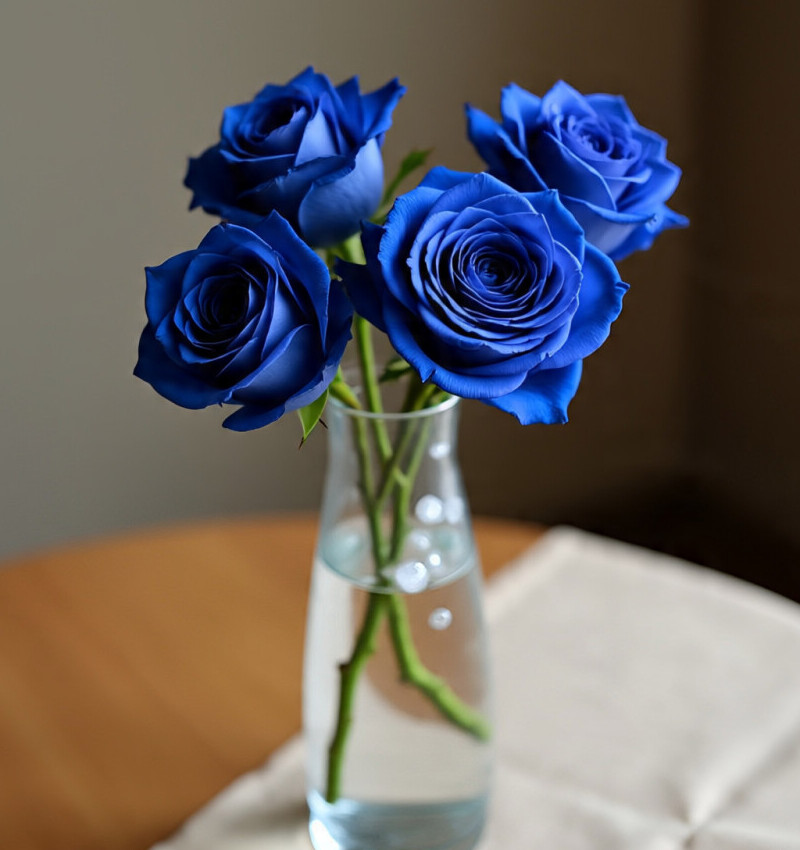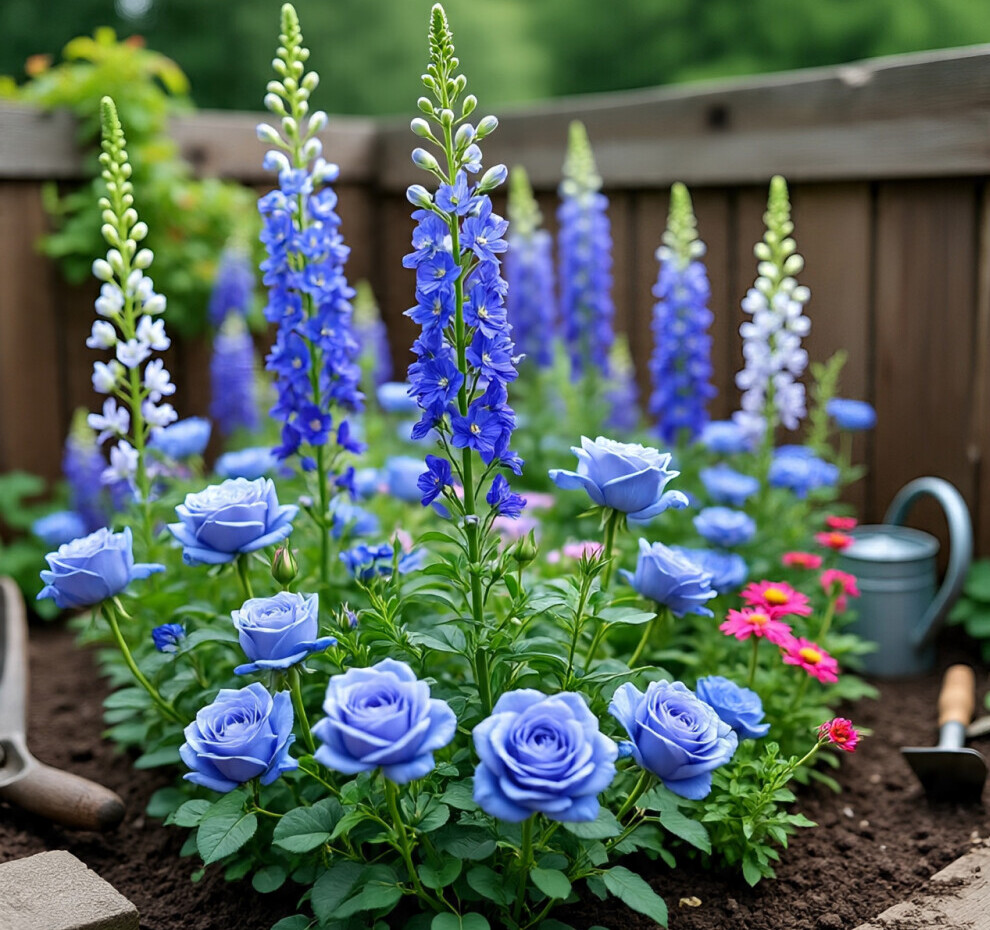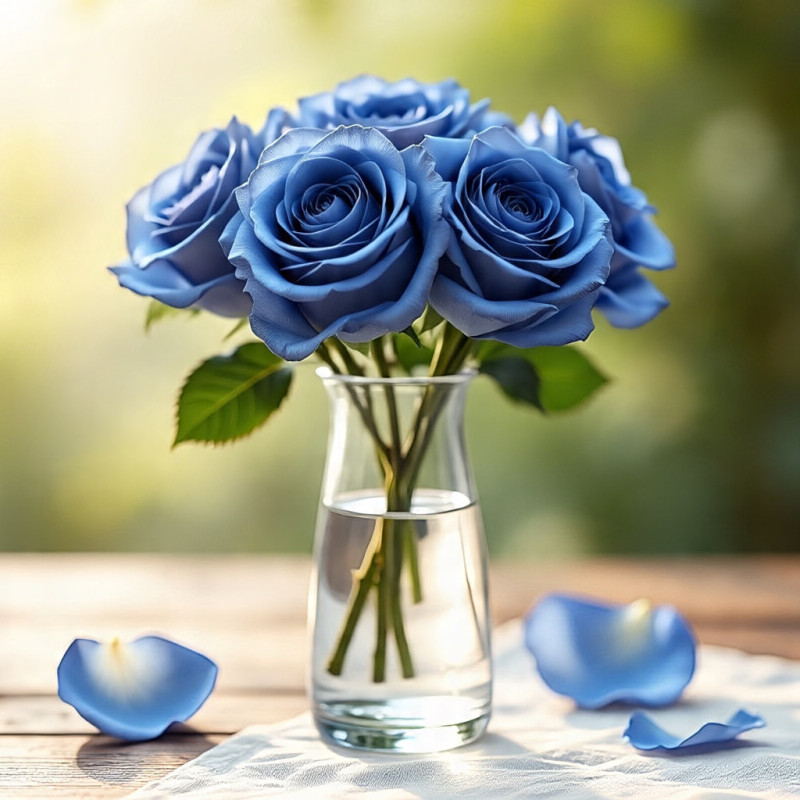Blue roses have this almost magical reputation. For centuries, gardeners, artists, and anyone who loves flowers have been intrigued by the idea of a rose as blue as a summer sky.
The catch is, true blue roses don’t actually grow in nature.
This has sparked stories, scientific experiments, and some really creative flower art along the way.
In this article, I’m sharing what makes blue roses so special, from the old myths to modern breeding, what they mean in different cultures, and even how you can enjoy blue roses in your own home.

The Myth of Blue Roses
Blue roses pop up in fairytales, poetry, and classic novels way more often than you’ll actually find them in real life.
Part of the story comes from basic biology: roses lack the gene needed to create delphinidin, which is the pigment for blue in flowers like delphiniums and some pansies. So, natural blue just isn’t something roses can pull off on their own.
This led people to all kinds of creative methods, including dyeing white roses with pigments or food coloring, to make something close to the myth. Since the real thing was missing from gardens, blue roses started taking on extra meaning.
In Chinese folklore, they often represent the impossible or the pursuit of a dream you just can’t quite catch.
In Victorian England and a bunch of other places, the blue rose became a symbol for mystery and love that’s unattainable.
That reputation has stuck, showing up in pop culture, tattoos, and even anime.
Breeding and Science Behind Blue Roses
Flower breeders have spent decades, sometimes centuries, trying to grow an authentic blue rose.
Traditional methods like crossing different colored roses or grafting didn’t get the job done. Rose petals leaned toward purple or mauve, but never a true blue.
Things got more interesting in the 1990s when scientists started working with genetic engineering to add the missing blue pigment gene from other flowers.
By 2004, a Japanese company called Suntory, working with Australian scientists, managed to insert blue pigment genes from pansies into a rose, resulting in the “Applause” rose.
Even then, most people would say it looks more lavender than true blue, but it was a pretty big step for flower science.
Of course, there’s still the good old-fashioned way: tinting or dyeing. Florists will often take a white rose, plop the stem in blue dye, and let the color climb up into the petals.
This trick works, but it means the blue is only on the surface and definitely not passed on in the plant’s DNA.
The challenge remains real. Even with gene editing, getting a satisfying, rich blue that matches what you see in other flowers is tricky.
Scientists are always working on new pigments and gene combinations, but so far, Mother Nature keeps blue roses as a sort of floral unicorn.
Popular Varieties Marketed as Blue Roses
Despite the science, the market for blue roses is strong, even if most of them aren’t truly blue in the natural sense.
- Suntory “Applause” Rose: This is the high-tech, genetically modified rose with a definite lavenderblue vibe. It stands out because of its backstory, and you’ll sometimes find florist shops showing them off as the only blue rose that isn’t dyed.
- Dyed or Tinted Blue Roses: These are usually white roses that have been placed in a blue dye bath. The color can be anywhere from sky blue to cobalt, depending on the mixture. These are the most common kinds you’ll see online or at your local florist for special occasions.
- Roses with Bluish Undertones: Several natural varieties have soft purples, lavenders, or mauves that sometimes look bluish under the right light. Names like ‘Blue Moon’, ‘Blue Girl’, and ‘Sterling Silver’ are worth checking out if you prefer growing something a little closer to blue.
Where to Find Blue Roses
If you’re looking to pick up a bouquet of blue roses, most chain and boutique florists have dyed blue roses, especially around big holidays like Valentine’s Day or during wedding season.
Ordering online makes it super easy, and you’ll find a ton of options on popular flower delivery websites. Just make sure you read the fine print; if it says “tinted” or “dyed,” you’re not getting a naturally blue flower.
Niche nurseries and garden centers sometimes sell blue-tinted roses or special lavender/purple varieties.
If you see so-called “blue rose seeds” online, double-check reviews and feedback. Many listings are scams or actually seeds for blue wildflowers, not roses.
When in doubt, contact the supplier directly or read gardening forums for honest experiences.
Specialty shops and wedding florists are also good spots for blue rose arrangements, especially for themed events.
If you’re after something a little different, you can request custom dye jobs for roses or mixed bouquets with blue as the focal color.
Watch out for vendors promising a “true blue rose” plant. So far, none exist for home gardeners.
Stick to reputable florists or garden centers, and always ask about the source of their blue roses.
Growing Blue Roses at Home (What’s Possible?)
If you love gardening and want blue roses in your garden, here’s the honest scoop: you won’t be growing a true blue rose from seed.
At least, not yet. The genetically engineered “Applause” rose isn’t really available for home growers, and dyed roses can’t be propagated to keep their blue color.
Your best bet is to go with lavender, purple, or mauve varieties like ‘Blue Girl’, ‘Blue for You’, or ‘Rhapsody in Blue’.
These types all have blueish tints, especially in cooler weather.
Healthy soil, slightly acidic and rich in organic matter, helps keep the color vibrant. Roses also show brighter hues in cooler climates or if grown in filtered sunlight.
If you’re in a hot, sunny area, some shade protection during the hottest hours helps a lot.
For special occasions, you can tint your own roses at home. Pick up white roses, fill a vase with water and floral dye (or even food coloring), and let the stems sit overnight.
The petals will soak up some eye-catching shades of blue, and the process is kind of fun to watch. Just keep in mind this color isn’t permanent and fades once the roses start to wilt.
If you want a wow factor in your landscaping, grouping purple, mauve, and pink roses together can create a bluish illusion from a distance.
Pairing these with accents of blue flowers like delphiniums or lobelias really makes your garden pop.
You can also play with colored mulch or blue ceramic pots to help accentuate the color scheme and trick the eye for a blue-themed look.
Symbolism of Blue Roses
Blue roses have pretty deep meaning in a bunch of different cultures, mostly because they’re rare—or flat out impossible—to find in nature.
In Western folklore, they’ve often stood for the idea of trying to reach the impossible. In China, stories paint them as a symbol for hope and unrequited love, often given as gestures of longing or admiration.
They’re also tied to mystery, royalty, and the desire for the unattainable.
For weddings, blue roses sometimes get used in bouquets for couples who love to stand out or want to suggest their love is “one of a kind.”
You’ll also find them in event decor and art as symbols for creativity, uniqueness, and going after big dreams. It’s cool how much demand comes just from what these flowers represent, even if they’re “faked” with dye, rather than made by nature.
On social media and in digital spaces, blue roses often represent individuality, creative spirit, and courage to go against the grain.
You’ll see them featured in everything from profile pictures on messaging apps to luxury branding to symbolize exclusivity and uniqueness.
Gift-giving traditions around blue roses have evolved too. They’re sometimes presented to someone who’s achieved something thought to be impossible, as a token of admiration or encouragement to “never give up.”
Recommended Products
- Blue Rose Bouquets (Dyed/Tinted): Online florists like FTD and 1-800-Flowers often carry blue-dyed rose arrangements for delivery.
- Lavender or Purple Rose Plants: Look for live plants or bareroot roses in varieties such as ‘Blue Girl’, ‘Sterling Silver’, or ‘Rhapsody in Blue’ from shops like Amazon Heirloom Blue Roses
- Rose Care Products: Rose fertilizer blends, organic soil mixes, and self watering stakes can help you grow healthy, vibrant blooms at home. These are available from most garden centers or online retailers like Amazon.
- Books on Rare and Unusual Roses: Titles like “RHS Encyclopedia of Plants and Flowers” and “The Rose: The History of the World’s Favourite Flower in 40 Roses” are really helpful if you’re curious about unique varieties, history, and growing tips.
FAQs About Blue Roses
Are blue roses real or fake?
Genetically modified blueish roses exist, but most blue roses you see in shops are dyed or tinted. True blue roses aren’t naturally found in the wild or in traditional gardens.
Can you grow blue roses from seeds?
No. There aren’t any seeds available that grow into blue roses. Some lavender or mauve roses may come close, but there’s no true blue rose seed on the market.
What does a blue rose symbolize?
Blue roses often stand for mystery, the impossible, unattainable love, or uniqueness. Symbolism can vary depending on the culture and context, but it almost always points to something rare or special.
Where can I buy real blue roses?
Florists and online stores sell dyed blue roses year-round. For genetically modified versions, like the Suntory “Applause” rose, you’ll mostly find them in Japan or as a premium imported product in select floral boutiques.
Wrapping Up
Nobody has cracked the code on a truly blue rose in a garden bed yet, but that hasn’t stopped flower fans from being obsessed with them.
Whether you see them as a symbol of mystery, a pop culture curiosity, or just a cool bouquet choice, blue roses are here to stay.
Next in my series about unusual rose colors: Black Roses. I’ll cover what they mean, how to grow them, and which ones are available for your own dramatic garden or bouquet.
Happy gardening and stay tuned!
Here’s a little transparency: Our website contains Amazon affiliate links. This means if you click and make a purchase, we may receive a small commission. Don’t worry, there’s no extra cost to you. It’s a simple way you can support our mission to bring you quality content.”




I have tried to grow all types of roses without much success, when I seen your article on blue roses I just had to read it to learn more about them.
I found it interesting there is no such rose as a true blue rose in nature, what a surprise to learn florists dye them to sell blue roses to their customers.
Great information about seeds being sold as blue rose seeds and are actually wildflower seeds instead.
Thank you for such an informative article on blue roses
Jeff
Thanks for sharing your experience, Jeff!
I’m glad you found the article informative and interesting.
It’s indeed fascinating how florists use dye to create blue roses, and the seed scam is quite surprising. If you’re still interested in growing roses, I’d be happy to share some tips or recommend some beginner-friendly varieties.
Maybe one day we’ll see a true blue rose through genetic engineering!